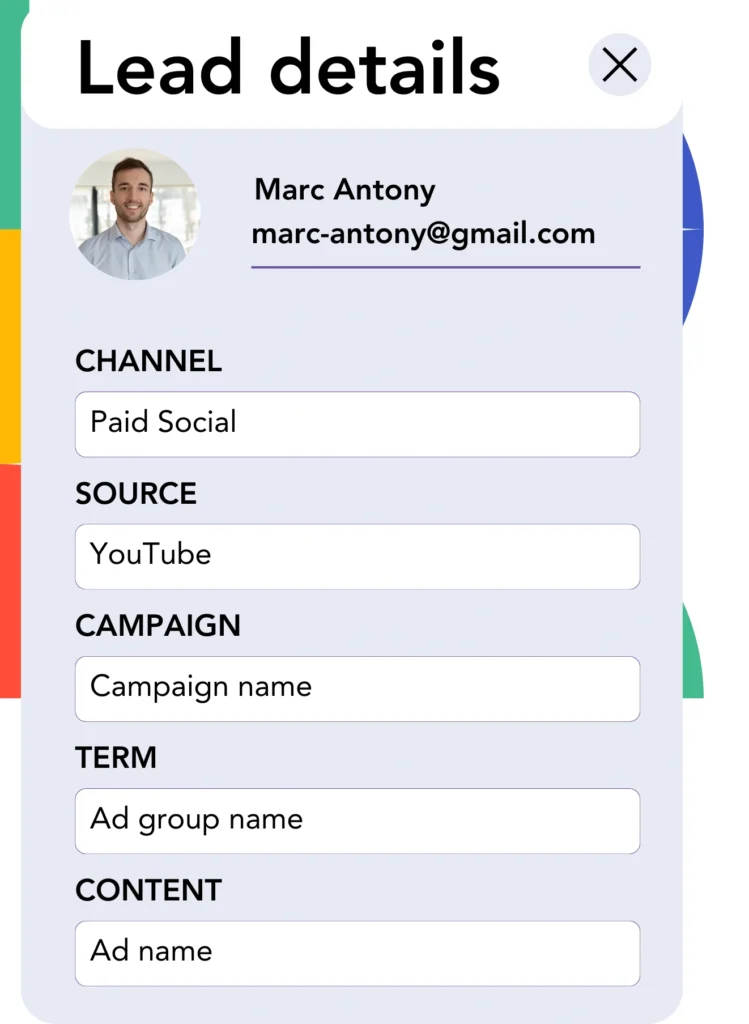You get leads on YouTube and transfer them into LeadSquared, yet each lead’s connection to a specific YouTube ad cannot be tracked. As these leads turn into customers, the original YouTube ad remains untraceable.
This lack of tracking data makes it difficult to measure YouTube ads performance, making it hard to see which ads bring in leads and customers. As a result, you invest in ads without understanding their effectiveness.
Fortunately, there’s a reliable way to trace each lead back to the particular YouTube campaign, ad group, and ad that produced it.
Let’s go through it step by step!
How to Track YouTube Ads in LeadSquared
Step 1: Add Leadsources in the head tag of your website

Leadsources is a simple tool for tracking where leads come from. Install it on your website, and then it can records up to 7 pieces of source information for every lead generated.
➡️ Sign up to Leadsources.io for free
➡️ Add the Leadsources tracking code to your site
Step 2: Add the UTM parameters to your YouTube Ads

To gather information from YouTube ads, add UTM parameters to your ad URL for tracking campaign, ad group, and ad details. You might use the following setup:
UTM_source=YouTubeUTM_campaign=campaign-nameUTM_term=ad-group-nameUTM_content=ad-name
The final version of your URL should look like this:
https://www.yourdomain.com/?&UTM_source=youtube&UTM_campaign=campaign-name&UTM_term=ad-group-name&UTM_content=ad-nameJust a note: Leadsources ensures complete lead tracking by capturing all source data, even without UTM parameters.
Step 3: Add the hidden fields in your form

Hidden fields are form inputs that are invisible to the user, but they store information that is sent with the form submission.
Leadsources saves the lead source data in hidden fields. When the lead submits the form, the fields are automatically filled with YouTube Ads data.
Step 4: Capture the YouTube Ads data in LeadSquared

Leadsources fetches the YouTube campaign, ad group, ad data, and additional details when users click on your ads and come to your site.
The YouTube ad data is placed into the hidden fields of your form by Leadsources.
After submitting the form, the YouTube ad data and lead details will be available for viewing in LeadSquared (you must link your form to LeadSquared).
How does Leadsources work?
As soon as a user visits your site, Leadsources fetches YouTube ad data and populates it into the hidden fields of your form. After submission, this data, along with the lead’s information, is sent to LeadSquared.
Leadsources keeps track of every lead’s source data, ensuring full visibility for each one:
| Lead source data | Fetched automatically |
| Channel | ✅ |
| Source | ✅ |
| Campaign | ✅ OR use UTM_campaign |
| Content | UTM_content parameter is required |
| Term | UTM_term parameter is required |
| Landing page | ✅ |
| Landing page subfolder | ✅ |
As reflected in the table above, when UTM parameters are not used—such as with organic sources like Google search or when your website is published in an article—Leadsources still records the following lead source data:
- Channel
- Source
- Campaign
- Landing page
- Landing page subfolder
Unlike other services, Leadsources tracks lead sources across every marketing channel, whether it’s organic or paid.
Performance reports: Lead, sales, and revenue by source
By using LeadSquared to track YouTube Ads data, you can create performance reports to measure success like:
- Leads, sales, and revenue by channel
- Leads, sales, and revenue by source
- Leads, sales, and revenue by campaign (aka. YouTube campaign)
- Leads, sales, and revenue by term (aka. YouTube ad group)
- Leads, sales, and revenue by content (aka. YouTube ad)
By using this data, you can adjust your YouTube Ads budget to maximize leads, sales, and revenue through the most impactful campaigns, ad groups, and ads.
Let’s check out some of the reports you can generate to track success!
1. Lead source reports
Generate comprehensive reports showing the number of leads produced by:
- Channel
- Source
- Campaign (aka. YouTube campaign)
- Term (aka. YouTube ad group)
- Content (aka. YouTube ad)
- Landing page
- Landing page subfolder
Example #1: Leads by channel
By using this report, you can track which marketing channel generates the most leads.

Example #2: Leads by YouTube campaign
This gives you the ability to focus on a specific lead source (e.g., YouTube) and track the lead count for each campaign.

Example #3: Leads by YouTube ad
Once you’ve identified the YouTube campaign producing the most leads, you can focus on the ad group or ad that’s generating them.

2. Sales and revenue source reports
Once we’ve determined which YouTube campaign, ad group, and ad generate leads, we should now analyze whether those leads are turning into sales and revenue.
For detailed tracking of your sales and revenue, connect your leads to a CRM like LeadSquared. This allows you to monitor the impact of various channels, sources, YouTube campaigns, ad groups, ads, landing pages, and subfolders.
Using these insights, you can optimize your YouTube Ads strategy to focus on the channels, sources, campaigns, ad groups, and ads that result in the highest sales and revenue.
You can create a wide variety of sales and revenue reports, such as:
- Sales and revenue by channel
- Sales and revenue by source
- Sales and revenue by campaign
- Sales and revenue by term (e.g., YouTube ad group)
- Sales and revenue by content (e.g., YouTube ad)
- Sales and revenue by landing page
- Sales and revenue by landing page subfolder
Example Scenario:
| Channel | Search Paid | Social Paid |
|---|---|---|
| Leads | 50 | 75 |
| Sales | 5 | 6 |
| Average Order Value | $150 | $100 |
| Revenue | $750 | $600 |
The first “Leads by Channel” report, after ads were launched on YouTube and Google, revealed that YouTube’s Social Paid ads brought in more leads than Google’s Search Paid ads.
After reviewing the sales and revenue data in LeadSquared, you found that the Search Paid channel was driving more revenue with fewer leads compared to the Social Paid channel. You adjusted your budget to allocate more resources to the Search Paid channel.
LeadSources tracks the source of each lead in LeadSquared, whether they come from ads, organic search, social, email, etc. and syncs that data with each submission. See the full breakdown on the lead source in LeadSquared page.

